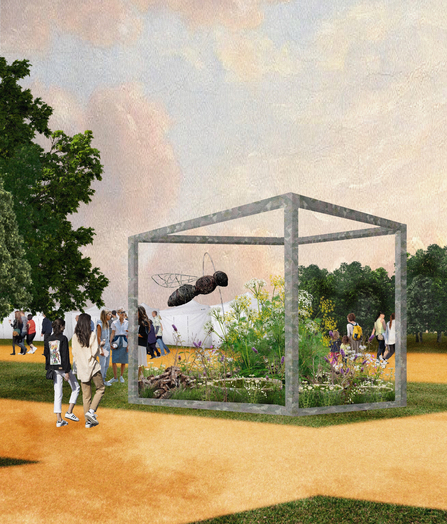Yorkshire Wildlife Trust, Sheffield and Rotherham Wildlife Trust, and designer Sam Galloway have joined forces to create an RHS-supported wildlife garden specifically designed to encourage the declining species.
Often mistaken for wasps and hornets, hoverflies are a vital part of the ecosystem. They are the second most significant pollinator after bees, eat aphids, provide food for birds and help to break down organic matter. Their distinctive markings and colours have gained them creative names, from the batman hoverfly to the footballer hoverfly – and yet a 44% decline in their distribution means hoverflies are now a red-listed species.
Elesha Searles, Community Nature Advisor at Sheffield and Rotherham Wildlife Trust, says, “Hoverflies are truly the unsung heroes in our gardens, and everyone can create spaces to help them to thrive. No space is too small: even a small yard can make a wonderful habitat for hoverflies. By creating spaces that cater to every stage in a hoverfly’s lifecycle, we can help hoverflies to thrive once more and help to halt the decline of the species.”
There are several different ways you can help hoverflies in your garden. Planting easily accessible flowers with open petal structures such as nasturtium, aubretia, yarrow, oxeye daisy and ivy offers plenty of food for hoverflies to thrive. Creating areas of pooled water and leaf litter offers a water source, and the perfect conditions for hibernation and shelter as the hoverfly moves through its lifecycle.
As Jo Rawson, Community Engagement Manager at Yorkshire Wildlife Trust explains, “Many species such as the tapered drone fly and batman hoverfly rely on water for egg laying and the larval stage of their life-cycle. An old bucket or container left tucked away with plenty of rotting leaves and some sticks will be perfect, and before you know it, you’ll be spotting hoverflies in your garden. For the Hoverfly Haven we’ve used beautiful old stone troughs to create this habitat.”
The centrepiece of the garden will be a magnificent willow sculpture of a hoverfly created by Leilah from Dragon Willow. Wild at Heart, a local community group in Rotherham, have helped to shape the garden design by creating willow hoverflies to bring the planting to life. The group works with adults with mental and physical health disabilities to actively participate in green social prescribing and nature-based wellbeing activities.

